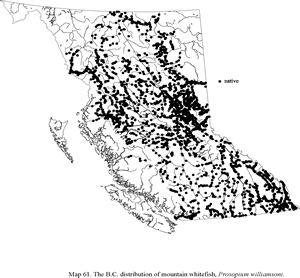Dorsal spines (total): 0; Dorsal soft rays (total): 11 - 15; Anal spines: 0; Anal soft rays: 10 - 13; Vertebrae: 53 - 61. Body slender, elongate, nearly cylindrical in cross section but variable, more compressed laterally than round whitefish. Head short; eye moderate, its diameter less than snout length; snout more or less pointed, compressed laterally, pinched, rounded in lateral view, a single flap of skin present between nostrils. Mouth small, ventral in position, overhung by snout; maxillaries extending posteriorly almost to anterior margin of eye in adults. Teeth small, restricted to a small patch on tongue and on gill rakers in adults, although small teeth may be present on the premaxillaries in young, but absent from jaws, vomer, palatines and pre maxillae in adults. Overall coloration silvery, but light or dark brown or olive on back, becoming silvery in sides and white below. Scales, specially on back, may have pigmented borders. dorsal fin often dusky, pelvic and pectoral fins in adults with amber tint.
Source: FishBase. Page, L.M. and B.M. Burr 1991 A field guide to freshwater fishes of North America north of Mexico. Houghton Mifflin Company, Boston. 432 p.
